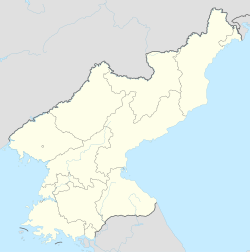Nampo
남포시 | |
|---|---|
| Nampho[1] | |
| Korean transcription(s) | |
| • Chosŏn'gŭl | 남포특별시 |
| • Hancha | 南浦特別市 |
| • McCune-Reischauer | Namp'o-t'ŭkpyŏlsi |
| • Revised Romanization | Nampo-teukbyeolsi |
 Clockwise from top: the West Sea Barrage, view of Nampo city, the Chongsan-ri co-operative farm, a monument | |
 Map of North Korea showing the location of Nampo | |
| Coordinates: 38°44′08″N 125°24′32″E / 38.73556°N 125.40889°E | |
| Country | |
| Administrative divisions | 5 guyok, 2 gun |
| Government | |
| • Party Committee Chairman | Ri Jae-nam[2] (WPK) |
| • People's Committee Chairman | Ri Kil-chun[3] |
| Area | |
| 1,281 km2 (495 sq mi) | |
| Population (2014[4]) | |
| 983,660 | |
| • Density | 770/km2 (2,000/sq mi) |
| • Urban | 703,317 |
| • Rural | 280,343 |
| • Dialect | P'yŏngan |
| Time zone | UTC+9 (Pyongyang Time) |
| [5] | |
Nampo (North Korean official spelling: Nampho; pronounced [nam.pʰo]), also spelled Namp'o, is a city in North Korea which is the country's fourth-largest by population. The city is an important seaport in the country as it lies on the northern shore of the Taedong River, 15 km east of the river's mouth. Formerly known as Chinnamp'o, it was a provincial-level "Directly Governed City" ("Chikhalsi") from 1980 to 2004, and was designated a "Special City" ("T'ŭkpyŏlsi", 특별시; 特別市) in 2010. Nampo is approximately 50 km southwest of Pyongyang, at the mouth of the Taedong River. Since North Korean independence, the city has developed a wide range of industry and has seen significant recent redevelopment.
- ^ "Tourism". Naenara. Retrieved 11 October 2021.
- ^ "Rodong Sinmun". Pyongyang: Rodong Sinmun. August 2020. Archived from the original on 2020-08-14. Retrieved 17 October 2018.
- ^ "Organizational Chart of North Korean Leadership" (PDF). Seoul: Political and Military Analysis Division, Intelligence and Analysis Bureau; Ministry of Unification. January 2018. Retrieved 17 October 2018.
- ^ Cite error: The named reference
univwwas invoked but never defined (see the help page). - ^ DPR Korean Central Bureau of Statistics: 2008 Population Census Archived 2010-03-31 at the Wayback Machine (2008 population census, published in 2009)
